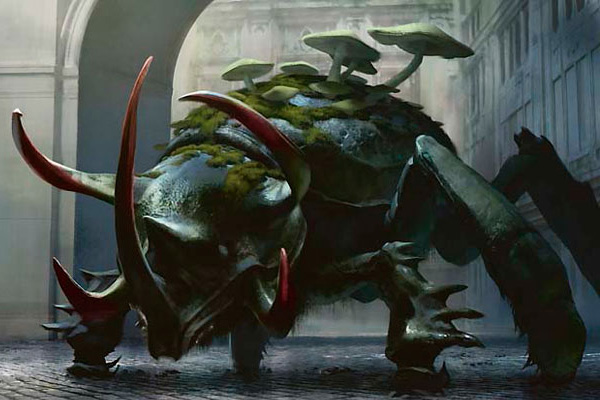Planeswalker's Guide to Return to Ravnica: Part 2
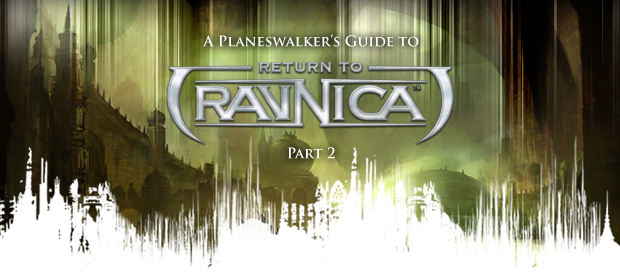
This is Part 2 of the Return to Ravnica Planeswalker’s Guide, the first part introduced you to Ravnica and the Selesnya guild. This week we look at the Izzet and Golgari guilds, and in two weeks we’ll talk about the Azorius and Rakdos guilds.
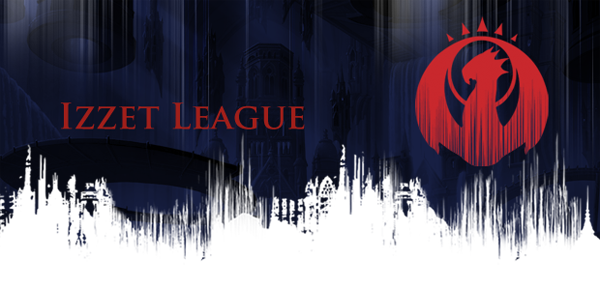
The Izzet are obsessive experimenters, the epitome of a keen creative intellect combined with an unfortunately short attention span. The original mandate of the Izzet guild was to provide solutions for public works projects (sewers, boilers, roadways), but their experiments often produce mana geysers, spatial rifts, or arcane portals instead. As of late, their guild leader, Niv-Mizzet, has driven the Izzet to delve deeper and deeper into more dangerous and experimental magic. The purpose of these experiments is unknown.
Niv-Mizzet, the Firemind, is the original parun of the Izzet League. He's a 15,000-year-old, vain, temperamental, and super-intelligent dragon. Niv-Mizzet has always been known for his unpredictability, vanity, and fiery temper, and these traits have only become more intense. Niv-Mizzet rarely stoops to concern himself with the day-to-day running of the guild, preferring to craft long-range plans and let his underlings implement the details.
The servants of Niv-Mizzet who make up his personal court are referred to as the Izmundi. Niv-Mizzet uses this court to guide his machinations and to keep him abreast of the happenings in the wider world. The Izmagnus are the most powerful members of the Izmundi court, which typically has five to seven members (some members are kept secret). Even members of the Izmagnus are not privy to Niv-Mizzet's highest-level plans and goals.
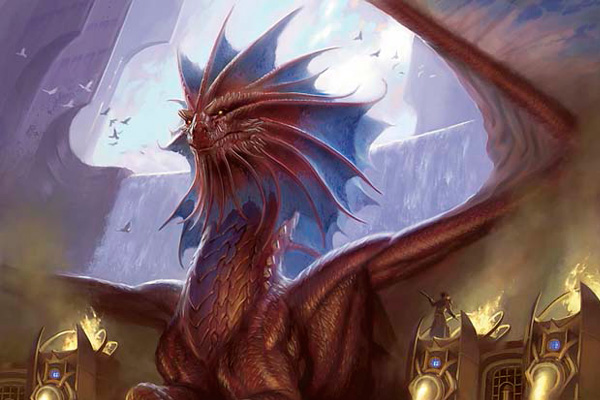
Niv-Mizzet, Dracogenius | Art by Todd Lockwood
Izzet Locations
Nivix, Aerie of the Firemind. Nivix, also known as the "Aerie of the Firemind," is the home of Niv-Mizzet and the central guildhall of the Izzet. Nivix is a massive tower, one of the tallest in Ravnica. Every level houses Izzet alchemists, mages, and sages who are constantly theorizing, experimenting, and tossing miscalculated experiments across rooms. The very top of the tower is the aerie of Niv-Mizzet himself. Every Izzet who lives and works in Nivix has been hand chosen by Niv-Mizzet. Although none of the experimentations in Nivix seem connected, the great dragon treats them all as if they were part of one grand experiment.
The Blistercoils. The Blistercoils appear to be a series of gigantic water wheels, which many assume are used to generate power in some way. In actuality, the interior structure of these wheels are actually made up of mizzium coils that generate copious, and volatile, amounts of mana. The Blistercoils is a recently constructed structure; its purpose (beyond generating dangerous amounts of mana) is unknown.
Boilerpits. The Boilerpits are a series of underground passageways formed by intertwined high-pressure metal pipelines. This twisted maze is so labyrinthine that very few besides the heat-hardy steam goblins can actually navigate them. The Izzet have been criticized in the past for using these tunnels to perform grand (and quite risky) experiments.
Mizzium Foundry. The Mizzium Foundry is the only place on Ravnica where the mizzium alloy is smelted. Mizzium is used for many Izzet inventions, and the foundry is protected by the savage flamethrower-wielding viashino. The heat within the foundry is stifling to most other races, but the viashino feel quite at home in this hot and humid environment.
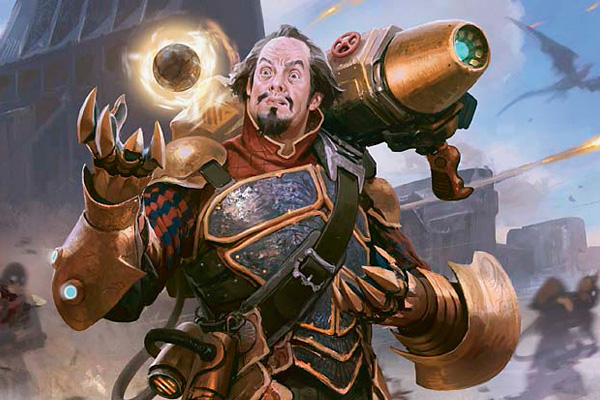
Art by Wesley Burt
Izzet Roles
Chemisters. The chemisters are alchemists who forge mizzium and other elements into arcane tools. They experiment with new alloys, energies, and runic markings. The chemisters are highly competitive, which often leads to spirited rivalries and petty in-fighting.
Blastseekers. Blastseekers are mages who wield and control the arcane tools devised by the chemisters. These tools are not always physical devices or artifacts; sometimes the blastseekers manipulate orbs of elemental energy that float in mutual orbits, crackling concentric disks of power, or streams of lava-bubbling water.
Attendants: Izzet blastseekers and chemisters might have up to forty attendants, most of whom are vedalken, due to their natural focus and organizational skills. An attendant's duties usually include recording and organizing information (often under dangerous circumstances), acquiring rare items or elements (usually under dangerous circumstances), or completing experiments (always under dangerous circumstances).
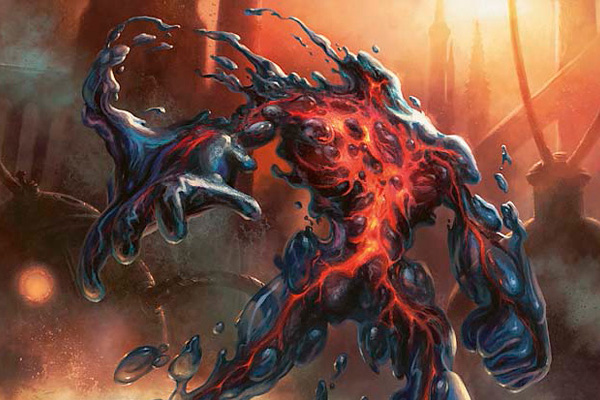
Art by Dan Scott
Weirds. Weirds are the product of yet another Izzet experiment whose goal was to combine two opposing elemental types (e.g., fire/ice, smoke/lightning, or steam/stone). Izzet mages hoped that these contradictory combinations might create elementals that were more stable and easier to control, but, of course, true to form for Izzet experimentation, the actual outcome was the exact opposite. Weirds are even wilder and more unpredictable than elementals of their component elements. However, weirds can make potent guardian creatures or fighting familiars.
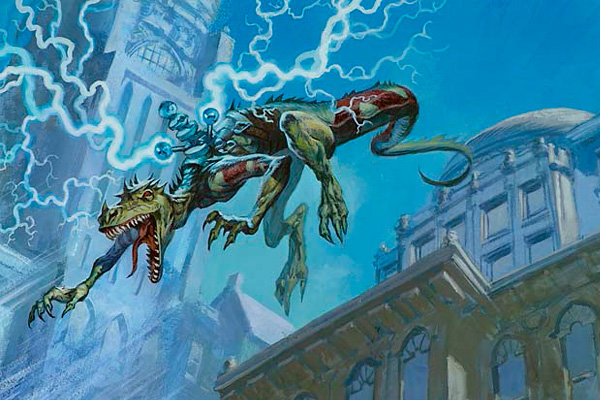
Art by Christopher Moeller
The Interlocus. Niv-Mizzet keeps information compartmentalized among the members of his guild. In his head, he keeps various experiments, research projects, and elemental explorations organized so he is the only one who perceives the way all of them intersect. As he receives the results from one line of experimentation, however chaotic its methods, he then orders a new line of experimentation on a seemingly unrelated topic. Niv-Mizzet demands to know the outcome of every concoction and elemental inquiry; even what might appears to be a failed experiment might later prove to be a key ingredient to Niv-Mizzet's larger plans.
Most believe him to be a batty, information-obsessed old dragon, but secretly, Niv-Mizzet is conducting a scattered, grand meta-project he calls the Interlocus. The purpose of the Interlocus—and indeed, its existence at all—is difficult to detect, as the sheer range and number of experiments that feed into it would fail to suggest any kind of pattern to most observers. But to the Firemind, all these lines of research help him get closer to answering the metaphysical riddles that perplex him.
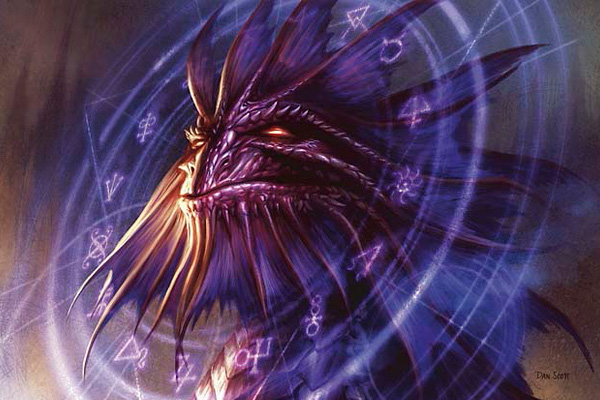
Art by Dan Scott
Izzet Attitudes Toward Other Guilds
Azorius: "The Azorius freely create rules for everything but freedom."
Boros: "Every time I'm on the verge of creating a little explosion that levels a city block, or a spell that rips a hole in reality and space time, the Boros show up to spoil the fun."
Dimir: "The less we see of the Dimir, the more we know they monitor us."
Golgari: "They are as bottomless as death. If you follow an ant long enough you will find its nest, but the nest is only the tiniest hint of the colony that lies below."
Gruul: "Thanks to the Gruul we no longer have to wait for natural disasters to have our laboratories destroyed. We rely on our careful protections from them, or else they would destroy all that we would hope to create."
Orzhov: "Progress means taking risks. But when you gamble with the Orzhov, you always wager more than coin."
Rakdos: "Steer clear of these senseless riot-fiends. The Rakdos are like a party to which all of your body parts might not be invited."
Selesnya: "Selesnyan zealots run with dogs and worship figments of the past. They would be wiser to embrace the wonders of the future."
Simic: "I can admire the inventiveness of the Simic, but the product of what they create lacks soul and fire. They feign to tinker with life, yet they lack the inspiration to breathe true life into their inventions."
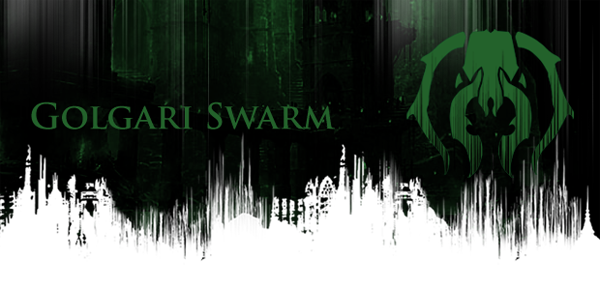
The Golgari Swarm is the guild that fuses the opposite values of life and death, fostering growth in Ravnica's decaying communities but also fostering decay in places of growth. The elves, zombies, insects, and undead-plant hybrids of the Golgari are like one massive, growing, feeding organism, collectively spreading across the plane wherever it can fit. The Golgari provide a necessary service in Ravnica, in that they dispose of the carcasses that civilization leaves behind, and mysteriously they also provide sustenance for the forgotten and the needy. They are the scavengers and decomposers at the fringes of the food chain, but yearn to be the predator at the top.

Golgari Guildgate | Art by Eytan Zana
The Golgari guild is organized more like a single organism than a collective: it has a nucleus or nerve center that drives the direction and growth of the guild; elements that collect nutrients and convert them into usable resources; defenses that resist and fight off foreign bodies; and an instinctual drive to survive, reproduce, and overcome.
The Golgari guildmaster is currently Jarad Vod Savo, an undead necromancer who managed to revive himself after death. In life, Jarad was an elvish archer and master hunter in the Golgari, and was the brother of the ambitious Savra (now deceased). Jarad learned the ways of necromancy and was able to rise as a lich after sacrificing himself to save his son from the demon Rakdos. Jarad now commands legions of piranha beetles and other flesh-eating pets, and can control the actions of insects and other decomposers. He has survived a number of assassination attempts from various upstarts, using the power of necromancy to feed off the power of his challengers.
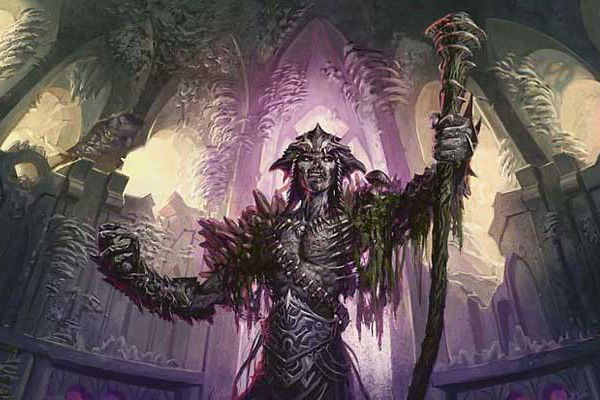
Jarad, Golgari Lich Lord | Art by Eric Deschamps
Jarad maintains a council of shamans and rogues called the Cilia. The Cilia act as a combination of advisory parliament and spy agency and rarely all convene publicly or together at once. In combination with Jarad's insect minions, they act as his sensory apparatus to know what the outer reaches of Golgari are doing and as a messenger service to deliver instructions. It might be that an individual Cilium might be considered of higher rank than another by Jarad, but none know those rankings beyond the guildmaster.
The Golgari guild might have more changes in leadership than other guilds. The guild believes in the importance of continuous cycles, understands that assassination is a valid means of political conquest, and knows that being alive is not a prerequisite to rule.
The Devkarin, elves of shadow. The Devkarin are a brooding, winsome, and often ambitious race of elves who represent one of the main power groups of the Golgari. Of all of Golgari's factions, the Devkarin press most for the expansion of Golgari territory; they feel that most of the other guilds do not have Ravnica's best interests at heart and that the more land consolidated in Golgari hands, the better. The Devkarin elves are ruled by a high priest known as a matka, sometimes for centuries at a time; Jarad's sister Savra was a former matka. The current matka is Zdenia, a severe, black-haired young woman whose hands and arms are tattooed with images of insects and spiders.
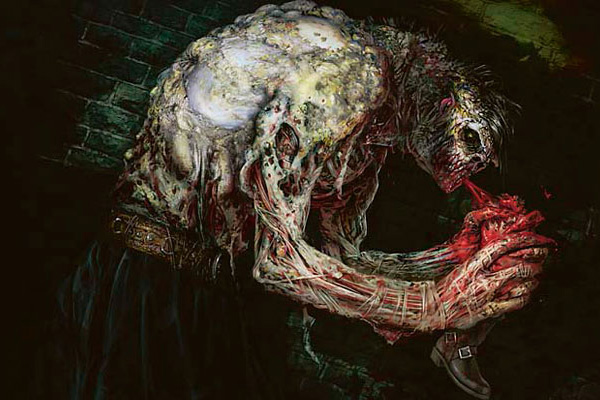
Art by Vincent Proce
The Lotleth, the ranks of death. The Lotleth are the Golgari's irregular faction of undead, necromancers, fungus-binders, and other members associated with the restless dead. Although most Golgari undead are mindless fungal constructions maintained by necromantic magic, the Lotleth do have some more or less intelligent undead among them, plus a few higher-ranked necromancers who speak for the faction. Generally, the Lotleth serve as a labor force for the Golgari's constant program of reclamation and expansion, or as a weapon for Jarad or some shaman's personal agenda. Sentient beings among Lotleth feel used and underappreciated within the guild, and their numbers are larger than they seem. The current leader of the Lotleth is Wratislav, a skilled but conceited human necromancer who enjoys parading his undead retinue through the streets of Ravnica.
The Street Swarm, shepherds of the cycle. The Street Swarm form Golgari's labor class, which helps drive the cycle of life and death by countless iterations of accelerating decay and seeding new life. This faction includes corpse scavengers, low-ranking street shamans, rot farmers, tunnel trolls, various elementals and fungal horrors, and most of the kraul (an insect-like race). Each neighborhood of Ravnica tends to have its own chapter of the Street Swarm, and each chapter is led by a local swarm-boss.
The Golgari Swarm is not an easy guild to lead; the unstoppable and constantly growing sub-factions of the guild are like mindless amoebas, each with its own agenda, and almost impossible to control. Jarad has held on to his position by bringing more power to the guild by actively reclaiming derelict districts of the plane. He knows the power-hungry Devkarin elves and the decomposing Lotleth undead will eventually dethrone him; in the meantime, he works to ensure a place on Ravnica for the Golgari and for his own family.
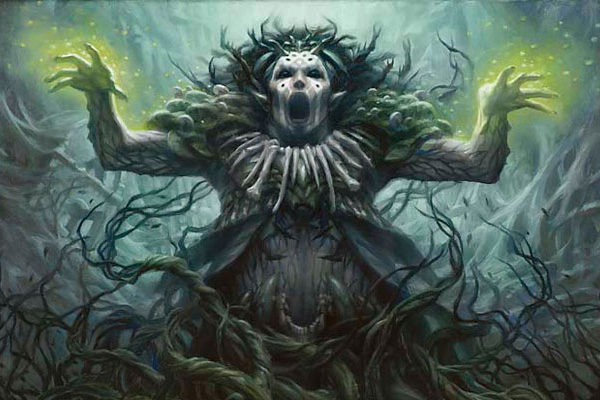
Korozda Guildmage | Art by Ryan Pancoast
Golgari Locations
Korozda, the Maze of Decay. Korozda is the new Golgari guildhall, an arched cathedral surrounded by an immense, circular maze of overgrown, fungus-encrusted ruins. Korozda is the lair of guildmaster Jarad Vod Savo and the place where he meets with the Cilia, his irregular court of attendants. Korozda is patrolled by an array of swarming vermin, giant insects, zombies, and gleancrawlers.
Stonefare. The Stonefare is a network of ancient, arched brick tunnels that wind through the Golgari-controlled areas of the undercity, polluted with sticky slime, fungi, and cobwebs. The Stonefare is lined with—and, in places, architecturally composed of—the petrified bodies of gorgon victims.
Deadbridge. At the center of the Golgari-controlled neighborhood of Deadbridge is a sinkhole large enough to swallow a church. Spanning the sinkhole is the Deadbridge itself, a massive platform supported by stone arches that are buttressed by vines, fungi, and bonewood. Deadbridge came by its name in a grisly fashion. After a deadly fire destroyed an adjoining neighborhood, the pit became a convenient, quiet way to dispose of corpses. The Golgari co-opted the sinkhole as a repository of raw materials, and eventually the guild came to be de facto in charge of the region.
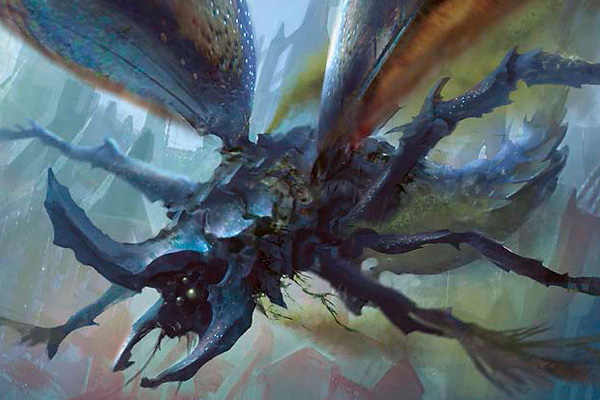
Art by Cliff Childs
Zanikev, the Great Rot Farm. Whenever an area of Ravnica has fallen into ruin, the Golgari seek to sweep in, accelerate its decomposition, drain it of its resources, reseed it, nourish it, and—eventually—claim the revivified sector as their territory. Zanikev is one particularly large Golgari reclamation zone that encompasses several former neighborhoods, an area of moss-coated and slime-choked architectural ruins where many scavenger species make their lair.
Corpsefloat Valves. The marsh-flooded tunnels and chambers of Ravnica's undercity are also a means of transport for the Golgari corpse trade. Valves constructed of fungal membranes close off certain sewerways. These valves open and close by Golgari command, allowing carcasses and other traffic to float through like a logging sluice.
